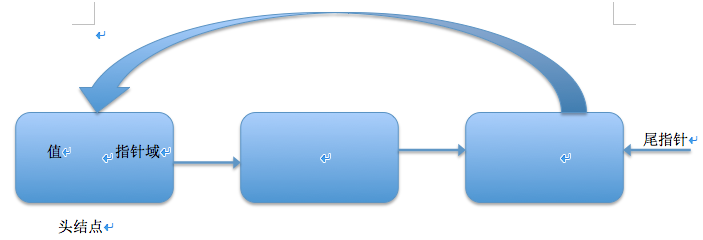Python实现的单向循环链表功能示例
2017-11-10 12:04
1121 查看
概述:
单向循环链表是指在单链表的基础上,表的最后一个元素指向链表头结点,不再是为空。

由图可知,单向循环链表的判断条件不再是表为空了,而变成了是否到表头。
操作
is_empty() 判断链表是否为空
length() 返回链表的长度
travel() 遍历
add(item) 在头部添加一个节点
append(item) 在尾部添加一个节点
insert(pos, item) 在指定位置pos添加节点
remove(item) 删除一个节点
search(item) 查找节点是否存在
具体代码:
class Node(object): """节点""" def __init__(self, item): self.item = item self.next = None class SinCycLinkedlist(object): """单向循环链表""" def __init__(self): self._head = None def is_empty(self): """判断链表是否为空""" return self._head == None def length(self): """返回链表的长度""" # 如果链表为空,返回长度0 if self.is_empty(): return 0 count = 1 cur = self._head while cur.next != self._head: count += 1 cur = cur.next return count def travel(self): """遍历链表""" if self.is_empty(): return cur = self._head print cur.item, while cur.next != self._head: cur = cur.next print cur.item, print "" def add(self, item): """头部添加节点""" node = Node(item) if self.is_empty(): self._head = node node.next = self._head else: #添加的节点指向_head node.next = self._head # 移到链表尾部,将尾部节点的next指向node cur = self._head while cur.next != self._head: cur = cur.next cur.next = node #_head指向添加node的 self._head = node def append(self, item): """尾部添加节点""" node = Node(item) if self.is_empty(): self._head = node node.next = self._head else: # 移到链表尾部 cur = self._head while cur.next != self._head: cur = cur.next # 将尾节点指向node cur.next = node # 将node指向头节点_head node.next = self._head def insert(self, pos, item): """在指定位置添加节点""" if pos <= 0: self.add(item) elif pos > (self.length()-1): self.append(item) else: node = Node(item) cur = self._head count = 0 # 移动到指定位置的前一个位置 while count < (pos-1): count += 1 cur = cur.next node.next = cur.next cur.next = node def remove(self, item): """删除一个节点""" # 若链表为空,则直接返回 if self.is_empty(): return # 将cur指向头节点 cur = self._head pre = None # 若头节点的元素就是要查找的元素item if cur.item == item: # 如果链表不止一个节点 if cur.next != self._head: # 先找到尾节点,将尾节点的next指向第二个节点 while cur.next != self._head: cur = cur.next # cur指向了尾节点 cur.next = self._head.next self._head = self._head.next else: # 链表只有一个节点 self._head = None else: pre = self._head # 第一个节点不是要删除的 while cur.next != self._head: # 找到了要删除的元素 if cur.item == item: # 删除 pre.next = cur.next return else: pre = cur cur = cur.next # cur 指向尾节点 if cur.item == item: # 尾部删除 pre.next = cur.next def search(self, item): """查找节点是否存在""" if self.is_empty(): return False cur = self._head if cur.item == item: return True while cur.next != self._head: cur = cur.next if cur.item == item: return True return False if __name__ == "__main__": ll = SinCycLinkedlist() ll.add(1) ll.add(2) ll.append(3) ll.insert(2, 4) ll.insert(4, 5) ll.insert(0, 6) print "length:",ll.length() ll.travel() print ll.search(3) print ll.search(7) ll.remove(1) print "length:",ll.length() ll.travel()
运行结果:

更多关于Python相关内容感兴趣的读者可查看本站专题:《Python数据结构与算法教程》、《Python加密解密算法与技巧总结》、《Python编码操作技巧总结》、《Python函数使用技巧总结》、《Python字符串操作技巧汇总》及《Python入门与进阶经典教程》
希望本文所述对大家Python程序设计有所帮助。
您可能感兴趣的文章:
相关文章推荐
- 基于Python单向循环链表实现尾部、任意位置添加,删除
- PHP简单实现循环链表功能示例
- 利用python实现简单的循环购物车功能示例代码
- python实现单向链表详解
- Java 单向链表和单向循环链表的代码实现
- Python实现嵌套列表及字典并按某一元素去重复功能示例
- Python实现的摇骰子猜大小功能小游戏示例
- 浅谈Python单向链表的实现
- 浅谈Python单向链表的实现
- Python实现的redis分布式锁功能示例
- Java实现单向链表的基本功能详解
- PHP实现链表的定义与反转功能示例
- 数据结构——双循环链表一部分功能的C语言实现
- Python简单实现阿拉伯数字和罗马数字的互相转换功能示例
- Python实现在线暴力破解邮箱账号密码功能示例【测试可用】
- 使用C++实现的单向循环链表
- 用单向循环链表实现约瑟夫环
- Python实现的计算器功能示例
- Python使用win32 COM实现Excel的写入与保存功能示例
- python实现单向链表
